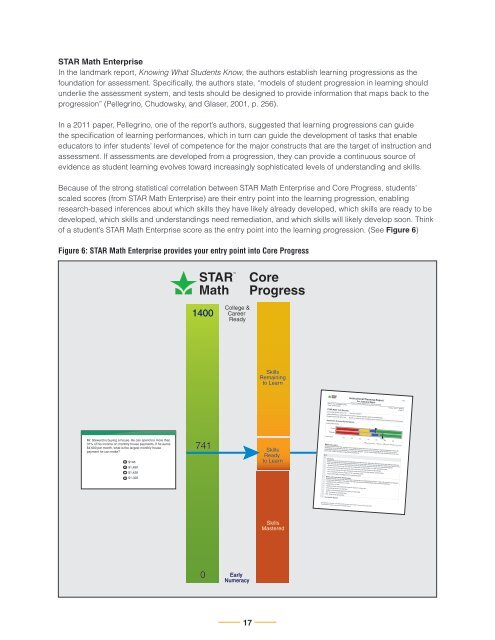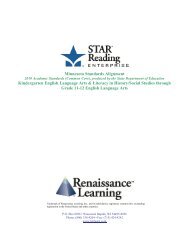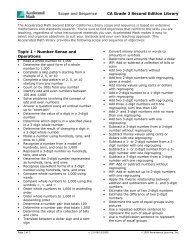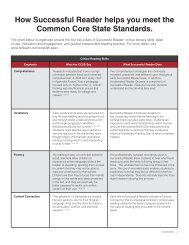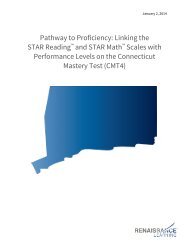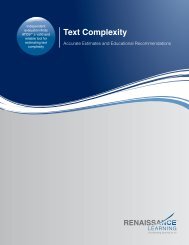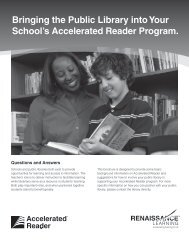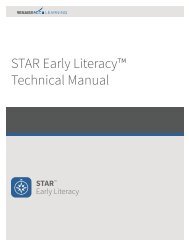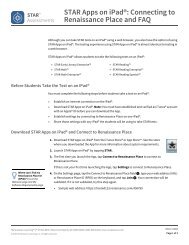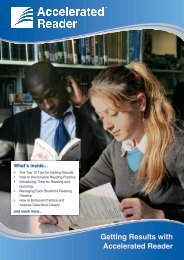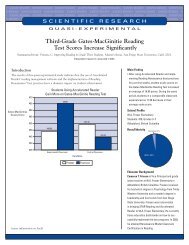Core Progress⢠for Math - Renaissance Learning
Core Progress⢠for Math - Renaissance Learning
Core Progress⢠for Math - Renaissance Learning
Create successful ePaper yourself
Turn your PDF publications into a flip-book with our unique Google optimized e-Paper software.
School: Pine Hill Middle SchoolClass: 5th Hour <strong>Math</strong>Current SS (Scaled Score): 741 Test Date: 9/5/2013Jasmine's Current Per<strong>for</strong>manceSchool BenchmarksaThis student was given extra time to complete the test.Printed Thursday, September 5, 2013 4:15:12 PMCurrentTeacher: Mrs. T. Wi liamsSTAR <strong>Math</strong> EnterpriseIn the landmark report, Knowing What Students Know, the authors establish learning progressions as thefoundation <strong>for</strong> assessment. Specifically, the authors state, “models of student progression in learning shouldunderlie the assessment system, and tests should be designed to provide in<strong>for</strong>mation that maps back to theprogression” (Pellegrino, Chudowsky, and Glaser, 2001, p. 256).In a 2011 paper, Pellegrino, one of the report’s authors, suggested that learning progressions can guidethe specification of learning per<strong>for</strong>mances, which in turn can guide the development of tasks that enableeducators to infer students’ level of competence <strong>for</strong> the major constructs that are the target of instruction andassessment. If assessments are developed from a progression, they can provide a continuous source ofevidence as student learning evolves toward increasingly sophisticated levels of understanding and skills.Because of the strong statistical correlation between STAR <strong>Math</strong> Enterprise and <strong>Core</strong> Progress, students’scaled scores (from STAR <strong>Math</strong> Enterprise) are their entry point into the learning progression, enablingresearch-based inferences about which skills they have likely already developed, which skills are ready to bedeveloped, which skills and understandings need remediation, and which skills will likely develop soon. Thinkof a student’s STAR <strong>Math</strong> Enterprise score as the entry point into the learning progression. (See Figure 6)Figure 6: STAR <strong>Math</strong> Enterprise provides your entry point into <strong>Core</strong> Progress1400College &CareerReadySkillsRemainingto LearnInstructional Planning Report<strong>for</strong> Jasmine Major1 of 2STAR <strong>Math</strong> Test ResultsGrade: 7Algebra Readiness: Jasminehas not yet me the algebra readiness grade level expectations.Projected SS <strong>for</strong> 06/16/14: 785 Based on research, 50% of students a this student's level wi l achieve this much growthCurrentProjectedMr. Steward is buying a house. He can spend no more than31% of his income on monthly house payments. If he earns$4,600 per month, what is the largest monthly housepayment he can make?A $148B $1,480C$1,426741SkillsReadyto LearnScaled Score 550 600 650 700 750 800 850Skills to LearnProjectedûUrgent Intervention ûIntervention ûOn Watch ûAt/Above BenchmarkJasmine's recent STAR <strong>Math</strong> scaled score(s) suggests these ski ls from <strong>Core</strong> Progress learning progressions would bechallenging, but no too di ficult <strong>for</strong> her. Combine this in<strong>for</strong>mation with your own knowledge of the student and use yourprofessional judgment when designing an instructional program. Use the <strong>Core</strong> Progress learning progressions to see howthese ski ls fit within the larger context of the progression.K-8GR7Students draw and construct geometrical figures and describe the relationship between figures with di ferent a tributes.GeometryThey solve real-world and mathematical problems involving angle measure and the area of 2-dimensional figures. Theysolve real-world and mathematical problems involving the surface area and volume of 3-dimensional figures.7 Relate volume found using unit cubes to multiplication of edge lengths in a right rectangular prism77 WP: Find the volume of a right rectangular prism with fractional edge lengths using <strong>for</strong>mulas7 Plot coordinates to <strong>for</strong>m a polygon on the coordinate plane7 Find a side length of a polygon on the coordinate plane» Find the volume of a right rectangular prism with fractional edge lengths using <strong>for</strong>mulasD $1,3267 Ratios and Proportional RelationshipsStudents analyze proportional relationships in real-world and mathematical problems. They write equations to representa proportional relationship. They solve multi-step real-world and mathematical ratio and percent problems.7 Understand the concept of a unit rate77 Identify an input-outpu table that contains values <strong>for</strong> a given ratio7 Find missing values in a ratio table7 Graph in the coordinate plane the values of a ratio table7 WP: Use tables to compare ratios7» Determine a unit rate» WP: Solve a unit rate problem7 The Number System» Designates a core ski l. <strong>Core</strong> ski ls identify the most critical ski ls to learn at each grade level.SkillsMastered0EarlyNumeracy17


